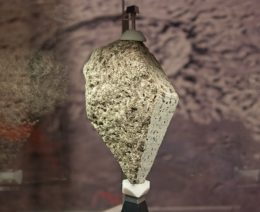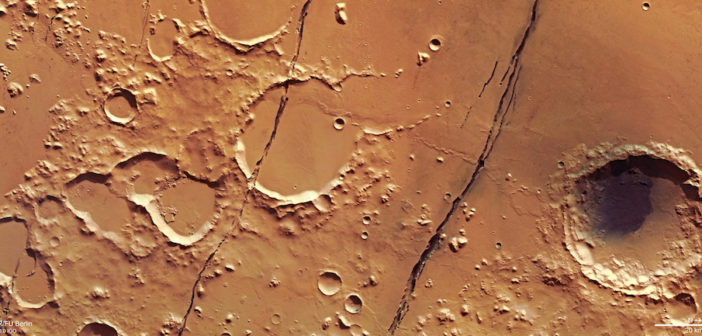On 4 March 2021, the Perseverance rover began rolling through Jezero crater on the surface of Mars. How old is the terrain it’s exploring? A recent study provides an updated answer.
An Impactful History

The landing site of the Perseverance rover on the floor of the Jezero crater. [NASA/JPL-Caltech/University of Arizona]
But how do we analyze the ages of more distant surfaces that we can’t touch, like planetary bodies in our solar system? This is where impact craters come in. Throughout their lifetimes, bodies in our solar system are peppered with small and large impactors that leave their mark in the form of impact craters. We can use these signatures to build a crater chronology — a timeline that allows us to interpret the ages of different surfaces on a body.

Lunar olivine basalt, collected by the crew of Apollo 15 and brought back to Earth. [Wknight94]
Building a Timeline
Relative aging of cratered surfaces is straightforward: older surfaces have a higher density of craters than newer ones, because older surfaces have had more time to be bombarded by rocky impactors. Areas of newer geology — for instance, where a lava flow resurfaced a region — have had less time to accumulate impact craters.
But how do we anchor these relative ages in an absolute timescale? That gets trickier. To start with, we need a calibration point. The Moon is ideal for this: we’ve brought back samples of lunar rocks and radiometrically dated them. These absolute dates then provide anchor points that allow us to establish a chronology for the lunar surface.
The Crux Is the Flux
To extrapolate this chronology to other bodies in our solar system — like Perseverance’s new home, Mars — we need two main things: good observations of the body’s crater counts, and an understanding of how the flux of impactors of different sizes has evolved over our solar system’s history.

These two simulated crater maps represent different potential bombardment histories for Mars: the top represents an early heavy bombardment ~4.5 billion years ago, and the bottom represents a late heavy bombardment ~4.1 billion years ago. [Marchi 2021]
Traversing Old Terrain
Marchi’s updated timelines change our predicted ages for Mars’s surface — including for the crater that Perseverance is now exploring. According to the author’s chronology, the dark regions of Jezero crater may be ~3.1 billion years old, which is up to 0.5 billion years older than was previously thought.
Mars’s crater chronology will doubtless be updated again as we continue to improve our models. But we have another prospect for anchoring this planet’s timeline: Perseverance’s goals include caching samples for future return to Earth. If successful, we’ll eventually have some Mars rocks on hand for radiometric dating, providing valuable insight into our solar system’s evolution.
Citation
“A New Martian Crater Chronology: Implications for Jezero Crater,” Simone Marchi 2021 AJ 161 187. doi:10.3847/1538-3881/abe417

